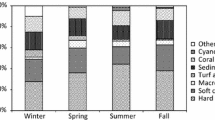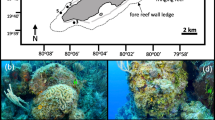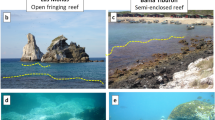Abstract
Calcification, a process common to numerous marine taxa, has traditionally been considered to be a significant source of CO2 in tropical waters only. A number of relatively recent studies, however, have shown that significant amounts of CO2 are also produced in temperate waters, although none of these studies was carried out on rocky shores, which are considered to be very productive systems. We compared the CO2 fluxes due to respiration and calcification in two temperate species, the cirripedes Chthamalus montagui and Elminius modestus. The population dynamics of both species were estimated at two sites during a 1-year experimental period in order to establish mean organic (ash-free dry weight) and CaCO3 (dry shell weight) production. Based on these parameters, we estimated the CO2 fluxes due to respiration and calcification. CaCO3 production was estimated to be 481.0 and \( {\text{1,803}}{\text{.9}}\,{\text{g}}_{{{\text{CaCO}}_{{\text{3}}} }} \,{\text{m}}^{{ - 2}} \,{\text{year}}^{{ - 1}} \) at each site, representing 3.4 and \( {\text{12}}{\text{.7}}\,{\text{mol}}_{{{\text{CO}}_{{\text{2}}} }} \,{\text{m}}^{{ - 2}} \,{\text{year}}^{{ - 1}} \) respectively, of released CO2. These fluxes represent each 47% of the CO2 released as a result of respiration and calcification. The production of CaCO3 at the high-density site was: (1) among the highest values obtained for temperate organisms, and (2) comparable to the estimated CO2 fluxes for coral reefs. As calcifying organisms are well represented in temperate ecosystems in terms of both density and biomass, our results provide clear evidence that calcification of temperate organisms should not be underestimated. Additional studies on other rocky shore taxa are needed before the relative importance of calcification in rocky intertidal carbon budgets can be generalized.



Similar content being viewed by others
References
Anger K (1978) Development of a subtidal epifaunal community at the island of Helgoland. Helgoland Mar Res 31:457–470
Anonymous (1986) Fifth report of the benthos ecology working group. International Council for the Exploration of the Sea (ICES), Copenhagen
Bahr LMJ (1976) Energetic aspects of the intertidal oyster reef community at Sapelo Island, Georgia (USA). Ecology 57:121–131
Bamber RN (1990) The effects of acidic seawater on three species of lamellibranch molluscs. J Exp Mar Biol Ecol 143:181–191
Barnes H (1971) Organic production by Elminius modestus Darwin in an enclosed basin. J Exp Mar Biol Ecol 6:79–82
Beukema JJ (1980) Calcimass and carbonate production by molluscs on the tidal flats in the Dutch Wadden Sea: I. The tellinid bivalve Macoma baltica. Neth J Sea Res 14:323–339
Beukema JJ (1982) Calcimass and carbonate production by molluscs on the tidal flats in the Dutch Wadden Sea: II The edible cockle, Cerastoderma edule. Neth J Sea Res 15:391–405
Bishop MWH (1947) Establishement of an immigrant barnacle in British coastal waters. Nature 159:201–205
Bishop MWH (1954) Elminius modestus in France. Nature 173:1145
Bishop MWH, Crisp DJ (1958) The distribution of the barnacle Elminius modestus Darwin in France. Proc Zool Soc Lond 131:109–134
Borges AV (2005) Do we have enough pieces of the jigsaw to integrate CO2 fluxes in the coastal ocean. Estuaries 28:3–27
Borges AV, Frankignoulle M (2003) Distribution of surface carbon dioxide and air-sea exchange in the English Channel and adjacent areas. J Geophys Res C 108. doi:10.1029/2000JC000571
Brey T, Rhumohr H, Ankar S (1988) Energy content of macrobenthic invertebrates: general conversion factors from weight to energy. J Exp Mar Biol Ecol 117:271–278
Bustamante RH, Branch GM, Eekhout S, Robertson B, Zoutendyk P, Schleyer M, Dye A, Hanekom N, Keats D, Jurd M, McQuaid C (1995) Gradients of intertidal primary productivity around the coast of South Africa and their relationships with consumer biomass. Oecologia 102:189–201
Chan BKK, Williams GA (2004) Population dynamics of the acorn barnacles, Tetraclita squamosa and Tetraclita amurensis (Cirripedia: Balanomorpha), in Hong Kong. Mar Biol 146:149–160
Charpy-Roubaud C, Sournia A (1990) The comparative estimation of phytoplanktonic, microphytobenthic and macrophytobenthic primary production in the oceans. Mar Microb Food Webs 4:31–57
Chauvaud L, Thompson JK, Cloern JE, Thouzaeu G (2003) Clams as CO2 generators: the Potamocorbula amurensis example in San Francisco Bay. Limnol Oceanogr 48:2086–2092
Chave KE (1967) Recent carbonate sediments – an unconventional view. J Geol Educ 15:200–204
Chiba S, Noda T (2000) Factors maintaining topography-related mosaic of barnacle and mussel on a rocky shore. J Mar Biol Assoc UK 80:617–622
Crisp DJ (1984) Energy flow measurements. In: Holme NA, McIntyre AD (eds) Methods for the study of marine benthos, 2nd edn. Blackwell, Oxford, p 387
Crisp DJ, Southward AJ, Southward EC (1981) On the distribution of the intertidal barnacles Chthamalus stellatus, Chthamalus montagui and Euraphia depressa. J Mar Biol Assoc UK 61:359–380
Cruz T, Castro JJ, Delany J, McGrath D, Myers AA, O’Riordan RM, Power AM, Rabaça J, Hawkins SJ (2005) Tidal rates of settlement of the intertidal barnacles Chthamalus stellatus and Chthamalus montagui in Western Europe: the influence of the night/day cycle. J Exp Mar Biol Ecol 318:51–60
Dame R, Vernberg F, Bonnell R, Kitchens W (1977) The North Inlet marsh–estuarine ecosystem: a conceptual approach. Helgoland Mar Res 30:343–356
Davoult D, Dewailly F, Migné A (1998) Carbon and nitrogen budget of a dense population of the suspension-feeding ophiuroid Ophiothrix fragilis (Albidgaard) in a macrotidal coastal ecosystem. In: Mooi R, Telford M (eds) Echinoderm. A. A. Balkema, Rotterdam, pp 337–342
Drévès L (2001) Effets climatiques sur les écosystèmes marins. Exemple du recrutement des Crustacés Cirripèdes sur la côte ouest du Cotentin. Hydroecol Appl 13:101–112
Duarte CM, Middelburg JJ, Caraco NF (2005) Major role of marine vegetation on the oceanic carbon cycle. Biogeosciences 2:1–8
Dye A (1993) Aspects of the population dynamics of Chthamalus dentatus (crustacea: Cirripedia) on the Transkei coast of Southern Africa. S Afr J Mar Sci 13:25–32
Feely RA, Sabine CL, Lee K, Berelson W, Kleypas J, Fabry VJ, Milero FJ (2004) Impact of anthropogenic CO2 on the CaCO3 system in the oceans. Science 305:362–366
Frankignoulle M, Canon C, Gattuso J-P (1994) Marine calcification as a source of carbon dioxide: positive feedback of increasing atmospheric CO2. Limnol Oceanogr 39:458–462
Fry WG (1975) Raft fouling in the Menai Strait, 1963–1975. Hydrobiologia 47:527–558
Fuji A, Watanabe H, Ogura K, Noda T, Goshima S (1991) Abundance and productivity of microphytobenthos on a rocky shore in southern Hokkaido. Bull Fac Fish Hokkaido Univ 42:136–146
Gattuso J-P, Allemand D, Frankignoulle M (1999) Photosynthesis and calcification at cellular, organismal and community levels on coral reefs: a review on interactions and control by carbonate chemistry. Am Zool 39:160–183
Gibbons MJ, Griffiths CL (1986) A comparison of macrofaunal and meiofaunal distribution and standing stock across a rocky shore, with an estimate of their productivities. Mar Biol 93:181–188
Glynn PW (1965) Community composition, structure, and interrelationships in the marine intertidal Endocladia muricata–Balanus glandula association in Monterey Bay, California. Beaufortia 12:1–198
Gros P, Cochard J-C (1978) Biologie de Nyctiphanes couchii (Crustacea, Euphasiacea) dans le secteur nord du golfe de Gascogne. Ann Inst Oceanogr 54:25–46
Harms J, Anger K (1989) Settlement of the barnacle Elminius modestus Darwin on test panels at Helgoland (North Sea): a ten year study. Sci Mar 53:417–421
Herbert RJH, Hawkins SJ (2006) Effect of rock type on the recruitment and early mortality of the barnacle Chthamalus montagui. J Exp Mar Biol Ecol 334:96–108
Jenkins SR, Aberg P, Cervin G, Coleman RA, Delany J, Hawkins SJ, Hyder K, Myers AA, Paula J, Power AM, Range P, Hartnoll RG (2001) Population dynamics of the intertidal barnacle Semibalanus balanoides at three European locations: spatial scales of variability. Mar Ecol Prog Ser 217:207–217
Kendall MA, Bedford ML (1987) Reproduction and recruitment of the barnacle Chthamalus montagui at Aberystwyth (mid-Wales). Mar Ecol Prog Ser 38:305–308
Kleypas J, Buddemeier RW, Archer D, Gattuso J-P, Langdon C, Opdyke BN (1999) Geochemical consequences of increased atmospheric carbon dioxide on coral reefs. Science 284:118–120
Lohse DP (1993) The effects of substratum type on the population dynamics of three common intertidal animals. J Exp Mar Biol Ecol 173:133–154
Magalhaes CM, Bordalo AA, Wiebe WJ (2003) Intertidal biofilms on rocky substratum can play a major role in estuarine carbon and nutrient dynamics. Mar Ecol Prog Ser 258:275–281
Martin S, Thouzeau G, Chauvaud L, Jean F, Guérin L (2006) Respiration, calcification, and excretion of the invasive slipper limpet, Crepidula fornicata L.: implications for carbon, carbonate, and nitrogen fluxes in affected areas. Limnol Oceanogr 51:1996–2007
Medernach L, Jordana E, Grémare A, Nozais C, Charles F, Amouroux JM (2000) Population dynamics, secondary production and calcification in a Mediterranean population of Ditrupa arietina (Annelida: Polychaeta). Mar Ecol Prog Ser 199:171–184
Ménesguen A, Hoch T (1997) Modelling the biogeochemical cycles of elements limiting primary production in the English Channel. I. Role of thermohaline stratification. Mar Ecol Prog Ser 146:173–188
Migné A, Davoult D, Gattuso J-P (1998) Calcium carbonate production of a dense population of the brittle star Ophiothrix fragilis (Echinodermata: Ophiuroidea): role in the carbon cycle of a temperate coastal ecosystem. Mar Ecol Prog Ser 173:305–308
Milliman JD (1993) Production and accumulation of calcium carbonate in the ocean: budget of a nonsteady state. Global Biogeochem Cycles 7:927–957
Moore HB (1972) An estimate of carbonate production by macrobenthos in some tropical, soft-bottom communities. Mar Biol 17:145–148
O’Riordan RM, Ramsay NF (1999) The current distribution and abundance of the Australasian barnacle Elminius modestus in Portugal. J Mar Biol Ass UK 79:937–939
O’Riordan RM, Arenas F, Arrontes J, Castro JJ, Cruz T, Delany J, Martinez B, Fernandez C, Hawkins SJ, McGrath D, Myers AA, Oliveros J, Pannacciulli FG, Power AM, Relini G, Rico JM, Silva T (2004) Spatial variation in the recruitment of the intertidal barnacles Chthamalus montagui Southward and Chthamalus stellatus (Poli) (Crustacea: Cirripedia) over an European scale. J Exp Mar Biol Ecol 304:243–264
Orr JC, Fabry VJ, Aumont O, Bopp L, Doney SC, Feely RA, Gnanadesikan A, Gruber N, Ishida A, Joos F, Key RM, Lindsasy K, Maier-Reimer E, Matear R, Monfray P, Mouchet A, Najjar RG, Plattner G-K, Rodgers KB, Sabine CL, Sarmiento JL, Schlitzer R, Slater RD, Totterdell IJ, Weirig MF, Yamanaka Y, Yool A (2005) Anthropogenic ocean acidification over the twenty-first century and its impact on calcifying organisms. Nature 437:681–686
Parsons TR, Takahashi M, Hargrave B (1984) Biological Oceanographic processes. Buttermorth-Heibemann, Exeter
Power AM, Delany J, McGrath CC, Myers AA, O’Riordan RM (2006) Patterns of adult baundance in Chthamalus stellatus (Poli) and C. montagui (crustacea: Cirripedia) emerge during late recruitment. J Exp Mar Biol Ecol 332:151–165
Raffaelli D (1979) The grazer-algae interaction in the intertidal zone on New Zealand rocky shores. J Exp Mar Biol Ecol 38:81–100
Raimondi PT (1988) Rock type affects settlement, recruitment, and zonation of the barnacle Chthamalus anisopoma Pilsbury. J Exp Mar Biol Ecol 123:253–267
Riebesell U, Zondervan I, Rost B, Tortell PD, Zeebe RE, Morel FMM (2000) Reduced calcification of marine plankton in response to increased atmospheric CO2. Nature 407:364–367
Rodgers J (1957) The distribution of marine carbonate sediments: a review, vol 5. Soc Econ Paleontol Mineral 5[Special Publ]:2–13
Sabine CL, Feely RA, Gruber N, Key RM, Lee K, Bullister JL, Wanninkhof R, Wong CS, Wallace DWR, Tilbrook B, Millero FJ, Peng T-H, Kozyr A, Ono T, Rios AF (2004) The Oceanic sink for anthropogenic CO2. Science 305:357–371
Schwinghamer P, Hargrave B, Peer D, Hawkins CM (1986) Partitioning of production and respiration among size groups of organisms in an intertidal benthic community. Mar Ecol Prog Ser 31:131–142
Segar DA, Collins JD, Riley JP (1971) The distribution of the major and some minor elements in marine animals. Part II. Molluscs. J Mar Biol Assoc UK 51:131–136
Smith SV (1972) Production of calcium carbonate on the mainland shelf of Southern California. Limnol Oceanogr 17:28–41
Southward AJ (1991) Forty years of change in species composition and population density of barnacles on a rocky shore near Plymouth. J Mar Biol Assoc UK 71:495–513
Ware JR, Smith SV, Reaka-kudha ML (1991) Coral reefs: sources or sinks of atmospheric CO2? Coral Reefs 11:127–130
Wu RSS, Levings CD (1979) Energy flow and population dynamics of the barnacle Balanus glandula. Mar Biol 54:83–89
Acknowledgments
The authors would like to thank E. Thiebaut for fruitful discussions, T. Cariou for acquiring the temperature data, G. Schaal for help on data acquisition and N. Guyard for help on figure editing. These experiments comply with current French laws.
Author information
Authors and Affiliations
Corresponding author
Additional information
Communicated by Martin Attrill.
Rights and permissions
About this article
Cite this article
Golléty, C., Gentil, F. & Davoult, D. Secondary production, calcification and CO2 fluxes in the cirripedes Chthamalus montagui and Elminius modestus . Oecologia 155, 133–142 (2008). https://doi.org/10.1007/s00442-007-0895-8
Received:
Accepted:
Published:
Issue Date:
DOI: https://doi.org/10.1007/s00442-007-0895-8




